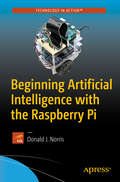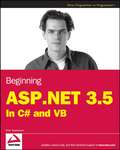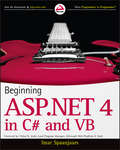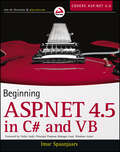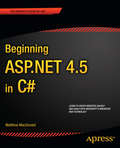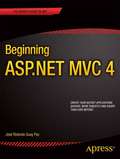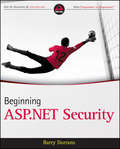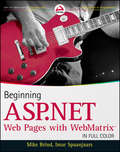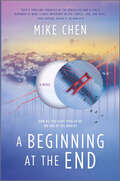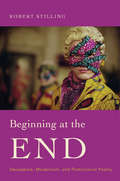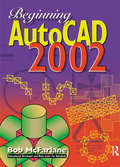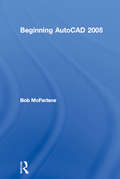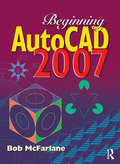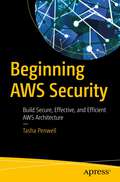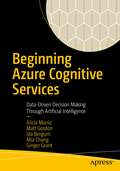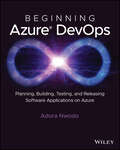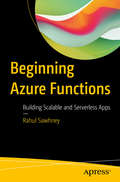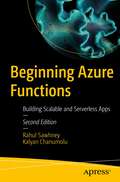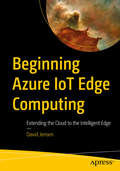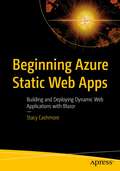- Table View
- List View
Beginning Armenian: A Communicative Textbook
by Charry KaramanoukianBeginning Armenian: A Communicative Textbook introduces conversational Western and Eastern Armenian in a single volume, allowing learners to acquire the language skills they need to communicate and to reference, contrast, and compare both standards of the language. This book contains 24 lessons, each providing a range of key vocabulary and addressing different topics of daily life, including greetings, people, and objects, as well as past and future plans. An overview of the Western and Eastern Armenian alphabet, pronunciation, and punctuation is complimented by a range of exercises introducing the basics of Armenian grammar and vocabulary, with interactive information gap and role play activities designed to develop essential conversation skills. Beginning Armenian is the ideal textbook to introduce class-based and independent learners to the Armenian language.
Beginning Artificial Intelligence with the Raspberry Pi
by Donald J. NorrisGain a gentle introduction to the world of Artificial Intelligence (AI) using the Raspberry Pi as the computing platform. Most of the major AI topics will be explored, including expert systems, machine learning both shallow and deep, fuzzy logic control, and more! AI in action will be demonstrated using the Python language on the Raspberry Pi. The Prolog language will also be introduced and used to demonstrate fundamental AI concepts. In addition, the Wolfram language will be used as part of the deep machine learning demonstrations. A series of projects will walk you through how to implement AI concepts with the Raspberry Pi. Minimal expense is needed for the projects as only a few sensors and actuators will be required. Beginners and hobbyists can jump right in to creating AI projects with the Raspberry PI using this book. What You'll Learn What AI is and--as importantly--what it is not Inference and expert systems Machine learning both shallow and deep Fuzzy logic and how to apply to an actual control system When AI might be appropriate to include in a system Constraints and limitations of the Raspberry Pi AI implementation Who This Book Is For Hobbyists, makers, engineers involved in designing autonomous systems and wanting to gain an education in fundamental AI concepts, and non-technical readers who want to understand what AI is and how it might affect their lives.
Beginning ASP.NET 3.5
by Imar SpaanjaarsThis book is for anyone who wants to learn how to build rich and interactive Microsoft ASP. NET web sites. With the knowledge you gain from this book, you create a great foundation to build any type of web site, ranging from simple hobby-related web sites to sites you may be creating for commercial purposes. Using this book's step-by-step format you'll learn to: Obtain, install, and customize Visual Web Developer (VWD) 2008 create a new web site and how to add new pages to it. use the numerous tools in VWD to create HTML and ASP. NET pages use the VWD tools and CSS, the language that is used to format web pages What ASP. NET server controls are, what they are used for, and how to use them program web pages Visual Basic or C# create consistent-looking pages through the use of master pages, skins, and themes build the navigation structure of your site create and use User Controls and enhance them to repeat content like menus and banners accept, validate, and process user input and send e-mail from your ASP. NET web application create good looking, flicker free web page interaction with ASP. NET Ajax the basics of SQL, the language used access and alter data in a database use the database tools found in Visual Web Developer use the ASP. NET data controls to create an interface for your users to interact with your application's data use LINQ to SQL to access SQL Server databases without writing a lot of manual code change the visual appearance of your data through the use of control styles interact with the data-bound controls and speed up your application use the security ASP. NET features to create user accounts, distinguish between anonymous and logged on users, and manage the users in your system create personalized web pages with content targeted at individual users find and fix problems with VWD debugging tools deploy and run your final web site
Beginning ASP.NET 4
by Imar SpaanjaarsThe definitive programming guide to ASP. NET, by popular author and Microsoft MVP Imar Spaanjaars Updated for ASP. NET 4, this introductory book retains its helpful examples and step-by-step format from the previous version and keeps the style of offering code examples written in both C# and Visual Basic. Beloved author and Microsoft ASP. NET MVP walks you through ASP. NET, Microsoft's technology for building dynamically generated Web pages from database content. You'll discover many improvements that ASP. NET 4 offers over the previous version, such as the ASP. NET MVC framework, Ajax improvements, jQuery support, and more. You'll gradually build a Web site example that takes you through the processes of building basic ASP. NET Web pages, adding features with pre-built server controls, designing consistent pages, displaying data, and more. Popular author and Microsoft ASP. NET MVP Imar Spaanjaars updates you on the latest updates to ASP. NET 4, Microsoft's technology for building dynamic Web pages from database content Shows you how the 4 version differs from ASP. NET 3. 5 and reviews its new features, including the ASP. NET MVC framework, various Ajax improvements, jQuery support, and more Spaanjaars's distinct writing style puts you at ease with learning ASP. NET 4.
Beginning ASP.NET 4.5: in C# and VB
by Imar SpaanjaarsThe ultimate programming guide to ASP. NET 4. 5, by popular author and Microsoft MVP Imar Spaanjaars Updated for ASP. NET 4. 5, this introductory book is filled with helpful examples and contains a user-friendly, step-by-step format. Written by popular author and Microsoft ASP. NET MVP Imar Spaanjaars, this book walks you through ASP. NET, Microsoft's technology for building dynamically generated web pages. This edition retains the highly accessible approach to building the Planet Wrox website example, an online community site featuring product reviews, picture sharing, bonus content for registered users, and more. Contains the comprehensive guide to the latest technology additions to ASP. NET 4. 5 Shows how to build basic ASP. NET web pages and configure their server Includes information on how to add features with pre-built server controls Reveals how to design pages and make them consistent Contains the information needed for getting user input and displaying data Beginning ASP. NET 4. 5 in C# and VB uses Spaanjaars's distinct writing style to put you at ease with learning ASP. NET 4. 5.
Beginning ASP.NET 4.5: In C# And Vb
by Imar SpaanjaarsThe ultimate programming guide to ASP.NET 4.5, by popular author and Microsoft MVP Imar Spaanjaars Updated for ASP.NET 4.5, this introductory book is filled with helpful examples and contains a user-friendly, step-by-step format. Written by popular author and Microsoft ASP.NET MVP Imar Spaanjaars, this book walks you through ASP.NET, Microsoft's technology for building dynamically generated web pages. This edition retains the highly accessible approach to building the Planet Wrox website example, an online community site featuring product reviews, picture sharing, bonus content for registered users, and more. Contains the comprehensive guide to the latest technology additions to ASP.NET 4.5 Shows how to build basic ASP.NET web pages and configure their server Includes information on how to add features with pre-built server controls Reveals how to design pages and make them consistent Contains the information needed for getting user input and displaying data Beginning ASP.NET 4.5 in C# and VB uses Spaanjaars's distinct writing style to put you at ease with learning ASP.NET 4.5.
Beginning ASP.NET 4.5 in C#
by Matthew MacdonaldThis book is the most comprehensive and up to date introduction to ASP. NET ever written. Focussing solely on C#, with no code samples duplicated in other languages, award winning author Matthew MacDonald introduces you to the very latest thinking and best practices for the ASP. NET 4. 5 technology. Assuming no prior coding experience, you'll be taught everything you need to know from the ground up. Starting from first principals, you'll learn the skills you need to be an effective ASP. NET developer who is ready to progress to more sophisticated projects and professional work. You'll be taught how to use object orientation and code-behind techniques to lay out your code clearly in a way other developers can easily understand. You'll learn how to query databases from within you web pages, spice up your layouts using ASP. NET AJAX and deploy your finished websites to production servers. You'll also learn how to debug your code when things go wrong and the performance and scalability issues that can affect your web projects as they grow. With you book you can take your first step towards becoming a successful ASP. NET developer with confidence. What you'll learn Learn everything you need to know to build ASP. NET 4. 5 applications with confidence. Dive into the deepest, broadest, introductory ASP. NET coverage available. Be guided by an award winning author who will steadily progress your knowledge from first principles to advanced techniques over the course of the book. Who this book is for This book is ideal for anyone new to . NET development who wants to learn how ASP. NET 4. 5 works. No prior programming knowledge is assumed and all concepts are explained from first principals. Table of Contents 1. The . NET Framework 2. The C# Language 3. Types, Objects, and Namespaces 4. Visual Studio 5. Web Form Fundamentals 6. Web Controls 7. Error Handling, Logging, and Tracing 8. State Management 9. Validation 10. Rich Controls 11. User Controls and Graphics 12. Styles, Themes, and Master Pages 13. Website Navigation 14. ADO. NET Fundamentals 15. Data Binding 16. The Data Controls 17. Files and Streams 18. XML 19. Security Fundamentals 20. Membership 21. Profiles 22. Advanced ASP. NET Components 23. Caching 24. LINQ and the Entity Framework 25. ASP. NET AJAX 26. Deploying ASP. NET Applications
Beginning ASP.NET for Visual Studio 2015
by William PenberthyThe complete guide to the productivity and performance enhancements in ASP.NET Beginning ASP.NET for Visual Studio 2015 is your ultimate guide to the latest upgrade of this historically popular framework. Fully updated to align with the vNext release, this new edition walks you through the new tools and features that make your workflow smoother and your applications stronger. You'll get up to speed on the productivity and performance improvements, and learn how Microsoft has committed itself to more continuous innovation by increasing its release cadence for all products and services going forward. Coverage includes Async-aware debugging, ADO.NET idle connection resiliency, managed return value inspection, ASP.NET app suspension, on-demand large object heap compaction, multi-core JIT and more. The news of an off-cycle update to ASP.NET came as a surprise, but its announcement garnered cheers at the 2014 Microsoft BUILD conference. This guide shows you what all the fuss is about, and how Microsoft overhauled the latest ASP.NET release. Get acquainted with the new developer productivity features Master the new tools that build better applications Discover what's new in Windows Store app development Learn how Microsoft fixed the issues that kept you from v5 Over 38 million websites are currently using ASP.NET, and the new upgrade is already leading to increased adoption. Programmers need to master v6 to remain relevant as web development moves forward. Beginning ASP.NET for Visual Studio 2015 walks you through the details, and shows you what you need to know so you can get up and running quickly.
Beginning ASP.NET for Visual Studio 2015
by William PenberthyThe complete guide to the productivity and performance enhancements in ASP.NET Beginning ASP.NET for Visual Studio 2015 is your ultimate guide to the latest upgrade of this historically popular framework. Fully updated to align with the vNext release, this new edition walks you through the new tools and features that make your workflow smoother and your applications stronger. You'll get up to speed on the productivity and performance improvements, and learn how Microsoft has committed itself to more continuous innovation by increasing its release cadence for all products and services going forward. Coverage includes Async-aware debugging, ADO.NET idle connection resiliency, managed return value inspection, ASP.NET app suspension, on-demand large object heap compaction, multi-core JIT and more. The news of an off-cycle update to ASP.NET came as a surprise, but its announcement garnered cheers at the 2014 Microsoft BUILD conference. This guide shows you what all the fuss is about, and how Microsoft overhauled the latest ASP.NET release. Get acquainted with the new developer productivity features Master the new tools that build better applications Discover what's new in Windows Store app development Learn how Microsoft fixed the issues that kept you from v5 Over 38 million websites are currently using ASP.NET, and the new upgrade is already leading to increased adoption. Programmers need to master v6 to remain relevant as web development moves forward. Beginning ASP.NET for Visual Studio 2015 walks you through the details, and shows you what you need to know so you can get up and running quickly.
Beginning ASP.NET MVC 4
by Jose Rolando Guay PazBy now you'll have heard of ASP.NET MVC. This excitingnew approach to developing ASP.NET web applications has taken thedevelopment world by storm over the last few years. Now a mature technology suitable for mainstream use, its adoption has exploded in recent times. Until recently, ASP.NET MVC was regarded as an advanced technology only suitable for experienced developers with a strong knowledge of classic ASP.NET and C# coding behind them. This book overturns that prejudice and shows that the beautiful simplicity of ASP.NET MVC is just as suitable for novice developers venturing into real-world application design for the first time. With the aid of a fully worked demo application this bookexplains and demonstrates for you the three pillars of MVC in action. You'll see howthe Model, View and Controller patterns work together in a compliementarymanner to provide MVC's powerful results. There's never been a better time to learn how to use ASP.NETMVC 4. The technology will speed your development times, reduce theverbosity of your code and simplify your application designs all at once. Takethe first step towards ASP.NET MVC mastery with Beginning ASP.NET MVC 4.
Beginning ASP.NET Security
by Barry DorransProgrammers: protect and defend your Web apps against attack!You may know ASP.NET, but if you don't understand how to secure your applications, you need this book. This vital guide explores the often-overlooked topic of teaching programmers how to design ASP.NET Web applications so as to prevent online thefts and security breaches.You'll start with a thorough look at ASP.NET 3.5 basics and see happens when you don't implement security, including some amazing examples. The book then delves into the development of a Web application, walking you through the vulnerable points at every phase. Learn to factor security in from the ground up, discover a wealth of tips and industry best practices, and explore code libraries and more resources provided by Microsoft and others.Shows you step by step how to implement the very latest security techniquesReveals the secrets of secret-keeping--encryption, hashing, and not leaking information to begin withDelves into authentication, authorizing, and securing sessionsExplains how to secure Web servers and Web services, including WCF and ASMXWalks you through threat modeling, so you can anticipate problemsOffers best practices, techniques, and industry trends you can put to use right awayDefend and secure your ASP.NET 3.5 framework Web sites with this must-have guide.
Beginning ASP.NET Web Pages with WebMatrix
by Imar Spaanjaars Mike BrindLearn to build dynamic web sites with Microsoft WebMatrixMicrosoft WebMatrix is designed to make developing dynamic ASP.NET web sites much easier. This complete Wrox guide shows you what it is, how it works, and how to get the best from it right away. It covers all the basic foundations and also introduces HTML, CSS, and Ajax using jQuery, giving beginning programmers a firm foundation for building dynamic web sites.Examines how WebMatrix is expected to become the new recommended entry-level tool for developing web sites using ASP.NETArms beginning programmers, students, and educators with all the information they need to start developing dynamic web sites, including design tips and layout adviceExplains the Packages Administration tool, including how to use the Facebook Social and Web Helper packagesCovers working with files, images, and databases; debugging and error handling; maintaining security; and site optimizationIn the tried-and-true tradition of Wrox Beginning guides, Beginning ASP.NET Web Pages with WebMatrix gives novice programmers the knowledge and confidence they need to get going.
A Beginning at the End: A Novel
by Mike ChenFour survivors unite in the aftermath of a global pandemic as the nation rebuilds in this character-driven postapocalyptic tale of family, love, and hope.From the New York Times–bestselling author of Star Wars: BrotherhoodSix years after a virus wiped out most of the planet’s population, former pop star Moira is living under a new identity to escape her past—until her domineering father launches a sweeping public search to track her down. Desperate for a fresh start herself, jaded event planner Krista navigates the world for those still too traumatized to go outside, but she never reaches out on her own behalf. Rob has tried to protect his daughter, Sunny, by keeping a heartbreaking secret, but when strict government rules threaten to separate parent and child, Rob needs to prove himself worthy in the city’s eyes by connecting with people again.Krista, Moira, Rob and Sunny meet by circumstance and their lives begin to twine together. When reports of another outbreak throw the fragile society into panic, the friends are forced to finally face everything that came before—and everything they still stand to lose. Because sometimes having one person is enough to keep the world going.“This postapocalyptic slice-of-life novel from Chen delivers big emotions by keeping the focus small. . . . By foregrounding family, Chen manages to imbue his apocalypse with heart, hope, and humanity. Sci-fi fans will delight in this lovingly rendered tale.” —Publishers Weekly (starred review, PW Picks)“Sometimes it is not the violent battles of post-apocalyptic stories that pull readers in; it is the emotional connection of humanity finding their way. Chen’s prose lights a brilliant, fragile path through the darkness.” —Library Journal (starred review)“The best kind of dystopian novel: one rooted deeply in the hearts of his characters and emphasizing hope and connection over fear. Chen has a true gift for making the biggest of worlds center around the most complex workings of hearts, and his newest is compelling, realistic, and impossible to put down.” —Booklist (starred review)
Beginning at the End: Decadence, Modernism, and Postcolonial Poetry
by Robert Stilling StillingDuring the struggle for decolonization, Frantz Fanon argued that artists who mimicked European aestheticism were “beginning at the end,” skipping the inventive phase of youth for a decadence thought more typical of Europe’s declining empires. Robert Stilling takes up Fanon’s assertion to argue that decadence became a key idea in postcolonial thought, describing both the failures of revolutionary nationalism and the assertion of new cosmopolitan ideas about poetry and art. In Stilling’s account, anglophone postcolonial artists have reshaped modernist forms associated with the idea of art for art’s sake and often condemned as decadent. By reading decadent works by J. K. Huysmans, Walter Pater, Henry James, and Oscar Wilde alongside Chinua Achebe, Derek Walcott, Agha Shahid Ali, Derek Mahon, Yinka Shonibare, Wole Soyinka, and Bernardine Evaristo, Stilling shows how postcolonial artists reimagined the politics of aestheticism in the service of anticolonial critique. He also shows how fin de siècle figures such as Wilde questioned the imperial ideologies of their own era. Like their European counterparts, postcolonial artists have had to negotiate between the imaginative demands of art and the pressure to conform to a revolutionary politics seemingly inseparable from realism. Beginning at the End argues that both groups—European decadents and postcolonial artists—maintained commitments to artifice while fostering oppositional politics. It asks that we recognize what aestheticism has contributed to politically engaged postcolonial literature. At the same time, Stilling breaks down the boundaries around decadent literature, taking it outside of Europe and emphasizing the global reach of its imaginative transgressions.
Beginning AutoCAD 2002
by Bob McFarlaneNew features in AutoCAD 2002 are covered in this book, making it a useful refresher course for anyone using AutoCAD at this level, and upgrading to the new software release. The material in the book is also relevant to anyone using other recent releases, including, AutoCAD 2000.
Beginning AutoCAD 2005
by Bob McFarlaneBeginning AutoCAD 2005 is a course based on learning and practising the essentials of 2D drawing using AutoCAD. Bob McFarlane’s hands-on approach is uniquely suited to independent learning and use on courses. The focus on 2D drawing in one book, ensures the reader gets a thorough grounding in the subject, with a greater depth of coverage than tends to be available from general introductions to AutoCAD. As a result, this book provides a true, step-by-step, detailed exploration of the AutoCAD functions required at each stage of producing a 2D drawing – an approach often not found in the many software reference guides available.The emphasis on learning through doing makes this book ideal for anyone involved in engineering, construction or architecture – where the focus is on productivity and practical skills. The author has also matched the coverage to the requirements of City and Guilds, Edexcel (BTEC) and SQA syllabuses.New features in AutoCAD 2005 are covered in this book including: Drafting Tools; Drawing Management; Drawing Output; Plot and Publish Tools; Productivity Tools; Sheet Set Manager, and Tool Palette Enhancements. The result is a useful refresher course for anyone using AutoCAD at this level, and those upgrading to the new software release. The course is also designed to be fully relevant to anyone using other recent releases, including AutoCAD 2004.Bob McFarlane is Curriculum Manager for CAD and New Media at Motherwell College, Scotland, and an Autodesk Educational Developer.
Beginning AutoCAD 2006
by Bob McFarlaneBeginning AutoCAD 2006 is a course based on learning and practising the essentials of 2D drawing using AutoCAD. Bob McFarlane’s hands-on approach is uniquely suited to independent learning and use on courses. The focus on 2D drawing in one book ensures the reader gets a thorough grounding in the subject, with a greater depth of coverage than tends to be available from general introductions to AutoCAD. As a result, this book provides a true, step-by-step, detailed exploration of the AutoCAD functions required at each stage of producing a 2D drawing – an approach often not found in the many software reference guides available.The emphasis on learning through doing makes this book ideal for anyone involved in engineering, construction or architecture – where the focus is on productivity and practical skills. The author has also matched the coverage to the requirements of City and Guilds, Edexcel (BTEC) and SQA syllabuses.New features in AutoCAD 2006 are covered in this book including: DYN (dynamic input showing coordinate position and lengths – an important new feature of the latest AutoCAD software), as well as new commands in the Modify and Dimension tool set. The result is a useful refresher course for anyone using AutoCAD at this level, and those upgrading to the new software release. The course is also designed to be fully relevant to anyone using other recent releases, including AutoCAD 2005.
Beginning AutoCAD 2007
by Bob McFarlaneBeginning AutoCAD 2007 is a course based on learning and practising the essentials of 2D drawing using AutoCAD. Bob McFarlane's hands-on approach is uniquely suited to independent learning and use on courses. The focus on 2D drawing in one book ensures the reader gets a thorough grounding in the subject, with a greater depth of coverage than tends to be available from general introductions to AutoCAD. As a result, this book provides a true, step-by-step, detailed exploration of the AutoCAD functions required at each stage of producing a 2D drawing - an approach often not found in the many software reference guides available.The emphasis on learning through doing makes this book ideal for anyone involved in engineering, construction or architecture - where the focus is on productivity and practical skills. The author has also matched the coverage to the requirements of City and Guilds, Edexcel (BTEC) and SQA syllabuses.The following new features in AutoCAD 2007 are covered in this book:* Create: Using enhanced commands and draughting tools to create all types of content* Manage: Using the Sheet Set Manager and Attribute Extraction to manage data and information* Produce: Using dynamic blocks, dynamic input and selection preview to increase productivity* Share: Using e-transmit, publish to the web and PDF files to share informationPlus, a new companion website features AutoCAD files for selected activities for students to work with.The result is a useful refresher course for anyone using AutoCAD at this level, and those upgrading to the new software release. The course is also designed to be fully relevant to anyone using other recent releases, including AutoCAD 2006.ABOUT THE AUTHOR Bob McFarlane has been writing books on AutoCAD for over 10 years.
Beginning AWS Security: Build Secure, Effective, and Efficient AWS Architecture
by Tasha PenwellImprove cloud security within your organization by leveraging AWS’s Shared Responsibility Model, Well-Architected Framework, and the Cloud Adoption Framework. This book will show you to use these tools to make the best decisions for securing your cloud environment. You’ll start by understanding why security is important in the cloud and then review the relevant services offered to meet an organization’s needs. You’ll then move on to the finer points of building a secure architecture and take a deep look into the differences of responsibility of managed services and those that allow customers more control. With multiple AWS services available, organizations must weigh the tradeoffs between those that provide granular control (IaaS), a managed service (PaaS), delivering applications remotely over the internet instead of locally on machines (SaaS). This book will help you to identify the appropriate resources and show you how to implement them to meet an organization’s business, technical, and security perspective in the Cloud Adoption Framework. Finally, you'll see how organizations can launch a secure and optimized cloud architecture and use monitoring tools to be proactive in security measures. With Beginning AWS Security, you'll understand frameworks, models, and the services needed to build a secure architecture. You will: Review the similarities and differences between cloud and traditional computing. See how security changes when using on-site, hybrid, and cloud models Develop an understanding that security is not “one and done” Reinforce the need for updates and monitoring as a continued part of AWS securityWho This Book Is ForCloud computing architects, security professionals, security engineers, and software professionals interested in Cloud security.
Beginning Azure Cognitive Services: Data-Driven Decision Making Through Artificial Intelligence
by Alicia Moniz Matt Gordon Ida Bergum Mia Chang Ginger GrantGet started with Azure Cognitive Services and its APIs that expose machine learning as a service. This book introduces the suite of Azure Cognitive Services and helps you take advantage of the proven machine learning algorithms that have been developed by experts and made available through Cognitive Services, easily integrating those algorithms into your own applications without having to develop the algorithms from scratch. The book also shows you how to use the algorithms provided by Cognitive Services to accelerate data analysis and development within your organization. The authors begin by introducing the tools and describing the steps needed to invoke libraries to analyze structured and unstructured text, speech, and pictures, and you will learn to create interactive chatbots using the Cognitive Services libraries. Each chapter contains the information you need to implement artificial intelligence (AI) via Azure Cognitive Services in your personal and professional projects. The book also covers ethical considerations that are becoming increasingly of concern when using AI to drive decision making. You will be introduced to tools such as FairLearn and InterpretML that can help you detect bias and understand the results your models are generating.What You Will LearnInvoke the Cognitive Services APIs from a variety of languages and appsUnderstand common design architectures for AI solutions in AzureDecrease discrimination and bias when creating an AI-driven solutionExecute the examples within the book and learn how to extend those examplesImplement best practices for leveraging the Vision, Speech, and Language parts of the suiteTest Cognitive Services APIs via the Azure portal and using the Postman API toolExecute AI from low-code and no-code platforms like Logic Apps and Microsoft’s Power PlatformWho This Book Is ForTechnical professionals who are interested in implementing artificial intelligence (AI) in pre-existing apps, expanding their value and skill sets, or learning more about AI for personal projects; for programmers working in languages such as C# and Python; and for those using low- and no-code platforms such as Microsoft Power Platform
Beginning Azure DevOps: Planning, Building, Testing, and Releasing Software Applications on Azure
by Adora NwodoThe perfect DevOps guide for beginning Azure users In Beginning Azure DevOps: Planning, Building, Testing and Releasing Software Applications on Azure, award-winning software engineer Adora Nwodo delivers a beginner's guide to DevOps on the Microsoft-powered Azure cloud platform. In the book, you'll learn to deploy Azure's built-in DevOps tools required to plan, build, test, and ship applications. The author explains how to use Azure's functionality for project management, version control, code testing, and continuous integration and continuous delivery (CI/CD). She discusses how to plan software development projects from start to finish using Agile and Scrum techniques. Readers will also find: Updated source code repositories on GitHub with instructive practice exercises Strategies for improving collaboration and automating your code-to-cloud workflows Techniques for securing your code with advanced capabilities An essential resource for Azure novices who hope to learn about the myriad possibilities unlocked by Azure DevOps tools, Beginning Azure DevOps will also earn a place in the libraries of software professionals familiar with other cloud platforms who hope to gain a foothold in the Azure cloud environment.
Beginning Azure Functions: Building Scalable and Serverless Apps
by Rahul SawhneyCreate highly scalable apps and monitor Azure functions in production using Azure Functions 2.0. This book takes you through durable functions for statefulness and covers not only the basics, but also how to create bindings in durable functions. It is a deep dive into the Azure Functions serverless API and will guide you through the process of converting monolithic applications to use Azure functions. The author starts by giving an overview of serverless architecture and Azure functions along with Azure App Services. You will then learn to create basic Azure functions using the Azure portal and Visual Studio. Next, you will create a serverless API using Azure Functions and migrate an existing application to Azure Functions. Finally, you will deploy an Azure function and monitor it in production. Here you will deploy the Azure function using ARM templates and secure and configure CORS for Azure functions. After reading this book, you will be able to understand Azure functions and create them using the Azure portal and Visual Studio. What You Will LearnUnderstand and use triggers and bindings in an Azure function Create a serverless API using Azure Functions and OpenAPIDeploy an Azure function and monitor it in productionUnderstand durable Azure functions, including scalability, disaster recovery, and geo-distributionWho This Book Is ForDevelopers who want to get started with Azure Functions. DevOps will also find value in the guidance for deploying and monitoring functions.
Beginning Azure Functions: Building Scalable and Serverless Apps
by Rahul Sawhney Kalyan ChanumoluStart creating highly scalable apps and monitoring your Azure functions in production using Azure Functions 4.0. This book thoroughly explains durable functions for statefulness, covering the basics all the way through how to create bindings in durable functions. It’s a deep dive into the Azure Functions serverless API and will guide you through the process of converting monolithic applications to use Azure Functions.This updated edition is revised to cover changes to Azure Portal and delves into Azure Functions runtime versions, the Isolated Process model, and offers a comparison of Azure Functions and Azure Logic Apps. You’ll also learn how to register binding extensions and gain an introduction to Azure Functions binding expression patterns, along with best practices for using Azure Functions. Beginning Azure Functions will provide you with the foundational knowledge to work with Azure Functions and teach you practical skills, such as how to create Azure Functions using different triggers and bindings. You’ll also see how to monitor your Azure Functions in production with live monitoring, and how to perform remote debugging and how to secure your functions.Upon completing this book, you’ll understand Azure Functions and how to create them using the Azure portal and Visual Studio. What You Will LearnUse triggers and bindings in an Azure function Create a serverless API using Azure Functions Understand durable Azure functions, including scalability, disaster recovery, and geo-distributionDeploy Azure Function and monitor it in productionWho This Book Is For Developers who want to get started with Azure Functions, as well as DevOps developers, who are looking for guidance in how to deploy and monitor functions.
Beginning Azure IoT Edge Computing: Extending the Cloud to the Intelligent Edge
by David JensenUse a step-by-step process to create and deploy your first Azure IoT Edge solution.Modern day developers and architects in today’s cloud-focused world must understand when it makes sense to leverage the cloud. Computing on the edge is a new paradigm for most people. The Azure IoT Edge platform uses many existing technologies that may be familiar to developers, but understanding how to leverage those technologies in an edge computing scenario can be challenging. Beginning Azure IoT Edge Computing demystifies computing on the edge and explains, through concrete examples and exercises, how and when to leverage the power of intelligent edge computing. It introduces the possibilities of intelligent edge computing using the Azure IoT Edge platform, and guides you through hands-on exercises to make edge computing approachable, understandable, and highly useful.Through user-friendlydiscussion you will not only understand how to build edge solutions, but also when to build them. By explaining some common solution patterns, the decision on when to use the cloud and when to avoid the cloud will become much clearer. What You'll LearnCreate and deploy Azure IoT Edge solutionsRecognize when to leverage the intelligent edge pattern and when to avoid itLeverage the available developer tooling to develop and debug IoT Edge solutionsKnow which off-the-shelf edge computing modules are availableBecome familiar with some of the lesser-known device protocols used in conjunction with edge computingUnderstand how to securely deploy and bootstrap an IoT Edge deviceExplore related topics such as containers and secure device provisioningWho This Book Is ForDevelopers or architects who want to understand edge computing and when and where to use it. Readers should be familiar with C# or Python and have a high-level understanding of the Azure IoT platform.
Beginning Azure Static Web Apps: Building and Deploying Dynamic Web Applications with Blazor
by Stacy CashmoreCreate rich and dynamic web applications on the Azure cloud platform using static web development techniques built around Blazor WebAssembly, APIs, and Markup, while leveraging the paradigm commonly known as JAMstack. This book starts off showing you how to create an environment for deploying your first application. You will create an Azure Static Web App using a Blazor WebAssembly application and adding dynamic content using an Azure function before deploying from GitHub. You will learn to debug your Static Web App locally, both inside of Visual Studio and from the command line using a simple Static Web App CLI command. The book takes a deep dive into the CLI to allow you to emulate all of the features available in the Azure environment. You will learn the authentication and authorizing options with your app and create new blog posts with the post creation function. Included in the book is setting a custom domain and discussion of the options. The book also explores the differences between the free and standard hosting tiers for Static Web Apps.After reading this book, you will be able to create Azure Static Web Apps using Blazor technology.What Will You LearnConnect with external authentication services from Twitter, Google, Microsoft, GitHub, and moreWork with the GitHub deployment flow, including using staging environmentsExplore the scaffolded Blazor appUnderstand differences between the pricing tiers and know which to chooseWho This Book Is ForWeb developers looking to deploy feature-rich applications to the cloud

